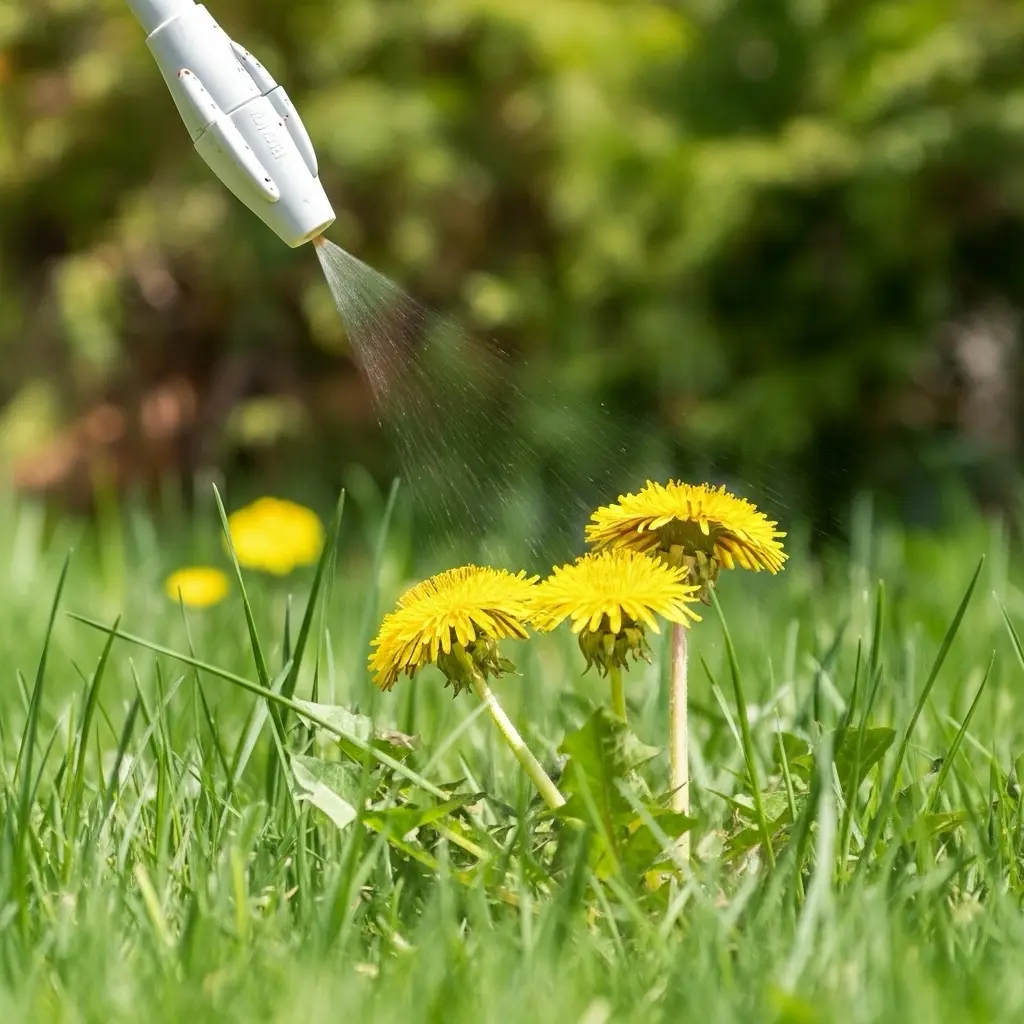A healthy, green lawn is the pride of any American home. But even the most beautiful lawns face an inevitable challenge weeds. The problem is, choosing the right weed control for lawns isn’t as simple as grabbing a bottle of “weed killer” off the shelf. Each region in the United States has unique grass species, soil types, climates, and weed pressures that determine what works best. This comprehensive guide will walk you through every factor — from herbicide science to regional examples so you can confidently select the ideal weed control method for your lawn.
Table of Contents

1. Understand Your Lawn’s Identity
Before you even think about applying herbicide, take time to identify your grass type and weed species. The United States spans multiple climate zones — and each region supports different turfgrasses with different tolerances.
Cool-Season Grasses (Northern U.S. & Midwest)
Examples include Kentucky bluegrass, perennial ryegrass, and tall fescue — common in states like Illinois, Michigan, Ohio, and Pennsylvania. These grasses thrive in cooler weather but can go dormant in hot summers. Many broadleaf weeds (like dandelions and clover) invade when lawns are heat-stressed.
Warm-Season Grasses (Southern U.S.)
Found in states like Texas, Florida, Georgia, and the Carolinas, warm-season species such as Bermuda, Zoysia, and St. Augustine grass prefer heat but slow down in winter. Summer weeds like crabgrass, nutsedge, and spurge dominate here.

Transition Zone (Central U.S.)
This challenging region — including parts of Missouri, Kansas, Tennessee, and North Carolina — experiences both extreme heat and cold. Lawns here often mix warm- and cool-season grasses, making weed control more complex because products safe for one may harm the other.
Tip:
Use online tools or contact your local county extension office to identify your turfgrass and common weeds in your ZIP code. Proper identification saves money and prevents lawn injury.
2. Recognize Weed Types and What They Mean
Weeds aren’t just nuisances — they tell stories about your soil’s condition. Understanding which weeds you’re battling helps you choose both the chemical and cultural (non-chemical) approach.
- Dandelions and Clover: Usually indicate low nitrogen or inconsistent fertilization.
- Nutsedge: Signals poorly drained or over-irrigated soil.
- Plantain or Chickweed: Suggest compacted soil or heavy foot traffic.
- Moss: Appears in shaded, acidic, and moist areas — often where grass can’t thrive.
Addressing these underlying issues (through aeration, better drainage, or proper fertilization) reduces future weed outbreaks before you even spray a drop of herbicide.
3. Learn the Major Herbicide Categories
Selective vs. Non-Selective Herbicides
Selective herbicides target weeds while sparing your grass. For example, a 2,4-D-based product can kill dandelions without harming Kentucky bluegrass. Non-selective herbicides, like glyphosate, kill anything green — perfect for sidewalk cracks or complete lawn renovation but dangerous for existing turf.
Pre-Emergent vs. Post-Emergent
- Pre-Emergent Herbicides: These stop weed seeds from germinating. They’re vital for controlling annual weeds such as crabgrass or goosegrass. Apply before soil temperatures hit 55°F for several days in a row — typically early April in the Midwest or February–March in the South.
- Post-Emergent Herbicides: These kill weeds already visible. They’re ideal for dandelions, clover, or other broadleaf species. Always apply when weeds are actively growing — not during drought or extreme heat, when absorption drops.
Contact vs. Systemic Action
Contact herbicides destroy plant tissue they touch, working best on small annual weeds. Systemic herbicides move through the plant to kill roots, effective against perennials like plantain or creeping Charlie.

4. Herbicide Resistance — A Growing U.S. Problem
Overusing the same product year after year can create “super weeds” resistant to herbicides. The most notorious example in U.S. lawns is Poa annua (annual bluegrass), now resistant to multiple chemical classes from the Midwest to the Southeast.
How to Prevent Resistance
- Rotate herbicides based on Mode of Action (MOA). The Weed Science Society of America assigns codes (e.g., Group 4 = growth regulators like 2,4-D). Never rely on one group repeatedly.
- Use tank mixes that combine two MOAs targeting different sites — but only if both are safe for your turf species.
- Alternate chemical and non-chemical methods: mow high, overseed bare patches, and maintain strong turf density.
- Spot-treat instead of blanket-spraying the entire lawn.
In the South and transition zones, where mild winters allow continuous weed growth, resistance builds faster. Homeowners in Georgia, Alabama, or southern Texas should rotate post-emergents yearly to avoid resistance buildup.
5. Timing Is Critical
Timing determines whether an herbicide helps or harms. Pre-emergents must be applied before seeds germinate, while post-emergents require active weed growth.
Regional Timing Examples
- Midwest (Chicago, Detroit, Cleveland): Apply pre-emergents between early April and mid-May; post-emergents for broadleaf weeds in late spring and fall.
- South (Houston, Orlando, Atlanta): Pre-emergents go down February–March; post-emergents in late spring once weeds show.
- Northeast (Boston, New York, Philadelphia): Target early April for crabgrass prevention and September for fall broadleaf treatment.
- Southwest (Phoenix, Las Vegas): Use pre-emergents in late winter before warm weather germinates summer weeds; watch for volatility under high temperatures.
Miss your timing, and you’ll waste product or stress your lawn unnecessarily. Local extension websites often publish “crabgrass germination maps” that track soil temperature by ZIP code — a valuable timing tool.
6. Drift and Volatility — The Silent Lawn Killers
Many homeowners accidentally damage their own landscapes or their neighbor’s gardens through herbicide drift — droplets or vapors moving off-target. Products containing dicamba are particularly volatile in hot weather.
Drift Prevention Strategies
- Spray in the early morning (after dew dries) or late afternoon when winds are calm but temperatures moderate (65–80°F).
- Use low-drift nozzles and keep the sprayer 18 inches or less above grass height.
- Never spray in wind speeds above 10 mph or during temperature inversions (common in early morning and evening).
- Leave unsprayed buffer zones around trees, gardens, or property lines.
Remember, in the U.S., EPA regulations make you legally responsible for drift damage. Always read the label for required nozzle types and wind limits — these are enforceable laws, not suggestions.
7. Integrating Weed Control With Lawn Care Practices
Herbicides work best as part of a broader turf management plan. A weak lawn will keep inviting weeds, no matter how often you spray.
Essential Cultural Practices
- Mowing Height: Mow at the high end of your grass’s range — about 3–4 inches for fescue, 2–3 inches for Bermuda. Taller grass shades soil, discouraging weed germination.
- Fertilization: Follow a soil test. Overfertilization encourages lush, weak growth; underfertilization invites weeds.
- Watering: Deep and infrequent watering builds deep roots and resists drought. Shallow, frequent watering favors shallow-rooted weeds.
- Aeration & Overseeding: Relieves compaction, improves nutrient flow, and thickens turf density — a natural weed deterrent.
Example:
In Indiana or Ohio, combining fall aeration with a balanced fertilizer and a pre-emergent next spring can cut annual weed pressure by up to 70% without heavy chemical use.
8. Legal and Environmental Considerations in the U.S.
The EPA regulates all herbicides nationwide, but individual states — like California, New York, and Oregon — often add stricter rules. Some municipalities even ban certain active ingredients for “cosmetic” lawn care. Always check local and state pesticide laws before purchasing or applying a product.
EPA Safety Tips to Remember
- Always wear gloves, long sleeves, and eye protection.
- Never apply near water bodies, storm drains, or during rain forecasts.
- Respect “re-entry” times (often 24 hours) before letting pets or kids back on the lawn.
- Store herbicides in labeled containers, out of sunlight, and away from fertilizers or fuel.
9. Soil Health and Herbicide Persistence
Healthy soil teems with microbial life that breaks down herbicides naturally. Repeated overuse, however, can harm microbes and reduce soil fertility. Integrate organic matter — compost, humic acid, or organic fertilizers — to restore biological balance.
For instance, in Kansas or Nebraska, where soils are heavy clay, organic amendments improve drainage and microbial activity, allowing herbicides to degrade faster and reducing residual buildup.
10. Precision Weed Control and Emerging Technologies
Technology is transforming lawn care across the United States. Commercial landscapers now use camera-guided “smart sprayers” that detect weeds and activate nozzles only where needed — reducing chemical use by up to 80%. Smaller versions for homeowners are in development.
Simple Precision Strategies for Homeowners
- Mark weed patches with flags and use a handheld sprayer instead of broadcasting across the lawn.
- Use smartphone apps or soil-temperature probes to fine-tune timing.
- Keep detailed logs of dates, products, and weather to spot performance trends.
Example:
In Florida, where high humidity can make herbicide volatility unpredictable, spot-treating using handheld precision sprayers is safer and more economical than full-lawn sprays.
11. Multi-Year Planning — Think Beyond One Season
Effective weed control isn’t a one-time fix — it’s an ongoing system. Create a three-year rotation plan combining chemical and cultural strategies.
Example Three-Year Rotation for Midwest Cool-Season Lawn
- Year 1: Apply a pendimethalin-based pre-emergent in spring, and a 2,4-D + dicamba post-emergent in fall.
- Year 2: Switch to a dithiopyr pre-emergent and triclopyr post-emergent for broadleaf control.
- Year 3: Use prodiamine pre-emergent; reduce chemical load by overseeding and improving mowing/fertilization.
This rotation not only prevents resistance but also lowers total chemical dependency while improving turf density.
12. Region-Specific Weed Challenges and Solutions
Northeast (Maine to Pennsylvania)
Cool-season weeds like chickweed and ground ivy dominate. Focus on fall post-emergents and spring crabgrass prevention. Overseeding in fall strengthens turf before winter.
Midwest (Illinois, Indiana, Wisconsin, Ohio)
Annual weeds like crabgrass and foxtail thrive after wet springs. Use pre-emergents in early April and maintain mowing height at 3–3.5 inches. Fall treatments with 2,4-D or triclopyr work well against dandelions.
Southeast (Florida, Georgia, Carolinas)
Watch for nutsedge, spurge, and dollarweed due to high humidity. Split pre-emergent applications in February and May. Avoid dicamba during high heat to prevent turf burn and drift.
Southwest (Arizona, New Mexico, Southern California)
Weeds like purslane and puncturevine thrive in sandy soils. Use low-volatility herbicides early in the morning and supplement with mulch around hardscapes to suppress regrowth.
Pacific Northwest (Washington, Oregon)
Cool, wet conditions favor moss and chickweed. Focus on soil pH correction (lime) and improving drainage rather than relying solely on herbicides.
Mountain West (Colorado, Utah, Montana)
Thin air and arid climate reduce competition but increase stress. Pre-emergents like dithiopyr work well, but prioritize drought-resistant turf varieties to prevent bare spots where weeds can invade.
13. Eco-Friendly and Organic Options
For homeowners seeking safer alternatives, organic products based on acetic acid, clove oil, or iron chelates can control some weeds, though they require more frequent applications. Corn gluten meal acts as a mild pre-emergent and fertilizer in one. While slower and less potent, these approaches reduce chemical exposure and improve soil health over time.
Example:
In California’s Bay Area, many municipalities encourage or mandate organic lawn care. Using corn gluten meal in spring and hand-pulling or vinegar sprays in summer aligns with local ordinances while keeping lawns attractive.
14. Building the Perfect Weed Control Strategy
When selecting the ideal weed control for lawns, balance three things: the right product, correct timing, and good cultural habits. Think of herbicides as precision tools, not permanent solutions.
- Identify your weeds and grass type accurately.
- Choose selective, turf-safe herbicides with clear MOA rotation.
- Apply at the right temperature and soil condition for your region.
- Integrate mowing, fertilization, and aeration to strengthen turf.
- Evaluate results yearly and adapt based on performance.
Conclusion
The journey to a weed-free lawn is a balance of science, timing, and care. Whether you live in the humid Southeast, arid Southwest, or cool Northern Plains, choosing the right weed control for lawns means understanding your local environment, reading your soil’s story, and applying herbicides responsibly. The best lawns aren’t just sprayed — they’re nurtured through smart strategy, healthy soil, and sustainable turf practices. With the right plan, your lawn can stay lush, resilient, and weed-free year after year.

